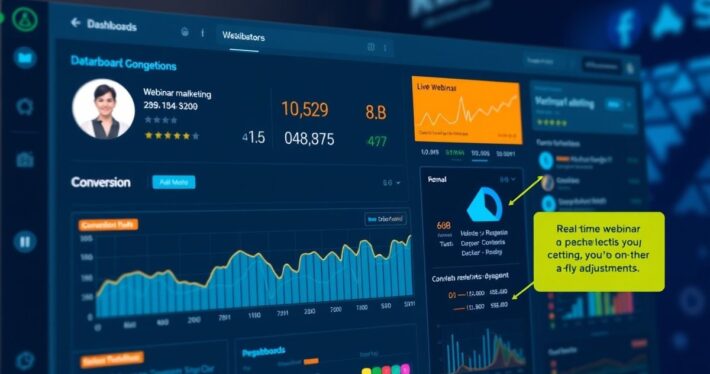Calculating Webinar ROI: Metrics and Methodologies

Calculating Webinar ROI: Metrics and Methodologies
Webinars have become a cornerstone of modern marketing strategies, offering a dynamic way to educate, engage, and convert audiences. But how do you know if your webinars are truly delivering a return on investment (ROI)? Calculating webinar ROI isn’t just about counting attendees or tracking sign-ups—it’s about diving deep into the metrics that matter and using methodologies that translate data into actionable insights. In this guide, we’ll break down the essential metrics, explore proven methodologies, and share real-world examples to help you master the art of webinar ROI calculation.
Why Webinar ROI Matters
Let’s be honest: webinars require time, effort, and resources. From planning and promotion to delivery and follow-up, each step comes with a cost. But when done right, webinars can generate significant revenue, nurture leads, and establish your brand as an authority. The key is understanding whether your investment is paying off—and, if not, why. Calculating webinar ROI allows you to measure success, identify areas for improvement, and make data-driven decisions for future campaigns.
Key Metrics for Measuring Webinar ROI
To calculate webinar ROI effectively, you need to focus on the right metrics. Here are the most important ones to track:
-
Registration Rate
Formula: (Number of registrations ÷ Total reach) × 100
Why it matters: This metric tells you how well your promotional efforts are working. A low registration rate could indicate issues with your targeting or messaging. -
Attendance Rate
Formula: (Number of attendees ÷ Number of registrations) × 100
Why it matters: Even if people register, they might not show up. A high attendance rate suggests strong audience interest and effective reminders. -
Engagement Metrics
- Average watch time: How long are attendees staying?
- Q&A participation: Are attendees asking questions or interacting?
- Poll responses: Are they engaging with your content?
Why it matters: Engagement is a leading indicator of interest and potential conversion.
-
Conversion Rate
Formula: (Number of conversions ÷ Number of attendees) × 100
Why it matters: This is where the rubber meets the road. Whether your goal is sales, lead generation, or sign-ups, conversions are the ultimate measure of success. -
Cost Per Acquisition (CPA)
Formula: Total webinar cost ÷ Number of conversions
Why it matters: CPA helps you understand the efficiency of your webinar in driving results. -
Revenue Generated
Formula: Total revenue directly linked to the webinar
Why it matters: This is the bottom line—how much money your webinar is bringing in.
Methodologies for Calculating Webinar ROI
Now that you know the metrics, let’s dive into the methodologies for calculating webinar ROI. Each approach offers unique insights, so choose the one that aligns with your goals.
-
Basic ROI Calculation
Formula: [(Revenue generated – Total costs) ÷ Total costs] × 100
Example: If your webinar generated $10,000 in revenue and cost $2,000 to produce, your ROI would be [(10,000 – 2,000) ÷ 2,000] × 100 = 400%.
Why it’s useful: This straightforward calculation gives you a clear percentage ROI. -
Attribution Modeling
Why it’s useful: Not all conversions happen during the webinar. Attribution modeling helps you assign credit to your webinar for influencing conversions over time. For example, if a lead attends your webinar and later purchases, you can attribute part of that revenue to the webinar. -
Lifetime Value (LTV) Integration
Why it’s useful: If your webinar nurtures long-term customers, consider calculating their lifetime value. For instance, if a webinar attendee becomes a repeat customer worth $5,000 over two years, that’s a significant ROI. -
Break-Even Analysis
Why it’s useful: This method helps you determine how many conversions or sales are needed to cover your costs. For example, if your webinar costs $1,000 and your average conversion value is $100, you need 10 conversions to break even.
Real-World Example: Scaling ROI with Strategic Tools
Let’s take the example of a SaaS company using AI-powered webinar tools to streamline their process and maximize ROI.
- Slide Outline Creator: By balancing education and engagement, they crafted a compelling presentation that kept attendees hooked for 90% of the webinar.
- Webinar Offer Builder: Structuring their pricing as a no-brainer deal increased conversions by 30%.
- High-Value Bonus Brainstormer: Adding exclusive bonuses made their offer irresistible, boosting sign-ups by 25%.
- Risk-Reversal Guarantee Generator: A 100% money-back guarantee reduced hesitations, leading to a 40% increase in sales.
By leveraging these tools, the company achieved a webinar ROI of 600%—proof that the right strategies and technologies can make a massive difference.
Common Challenges and How to Overcome Them
-
Attribution Issues
Challenge: It’s hard to track revenue directly tied to a webinar, especially if conversions happen later.
Solution: Use UTM parameters, CRM tracking, and post-webinar surveys to monitor attendee behavior. -
Low Engagement
Challenge: Attendees might drop off early or fail to interact.
Solution: Use polls, Q&A sessions, and interactive tools to keep them engaged. -
High Costs
Challenge: Producing a high-quality webinar can be expensive.
Solution: Leverage AI-powered tools to reduce production time and costs while maintaining quality.
Pro Tips for Maximizing Webinar ROI
-
Optimize Your Offer
A great webinar needs a compelling offer. Use tools like the Webinar Offer Builder to structure irresistible deals. -
Nurture Leads Post-Webinar
Don’t stop at the webinar. Follow up with attendees via email sequences, special offers, and additional content. -
Test and Iterate
Every audience is different. Test different presentation styles, offers, and timing to see what works best. -
Leverage Automation
Use automation tools for reminders, follow-ups, and analytics to save time and improve results.
Final Thoughts
Calculating webinar ROI isn’t just about crunching numbers—it’s about understanding the impact of your efforts and continuously improving. By focusing on the right metrics, applying proven methodologies, and leveraging strategic tools, you can turn your webinars into powerful revenue drivers.
So, what’s your next step? Start by analyzing your last webinar using the metrics and methodologies above. Then, identify one improvement to test in your next campaign. Remember, even small tweaks can lead to significant ROI gains.
Ready to transform your webinar strategy? Let’s make your next webinar your most profitable yet.



